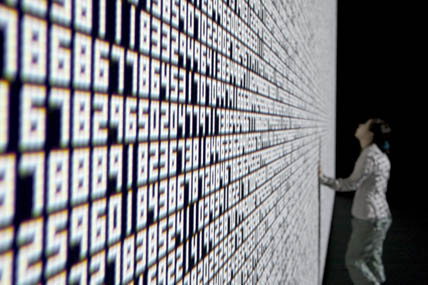Conclusion or Introduction
Today, the socially, economically and politically active population that includes the artists, cultural and educational agents, is simultaneously one of the most significant conveyers and promoters of the digital-informational paradigm of cognitive capitalism. Participating in the various modes of immaterial labour, in the affective production and symbolic processing, they act primarily as users/consumers, more or less successfully adopting and mastering the operative imperatives of digital technologies. Cognitive capitalism enforces the machinic and systemic character of relations, affairs and individuals whose identities become less important than their structural roles. The artists, cultural and educational agents are therefore usually not in the position, and are often not truly motivated, to thoroughly understand, to contest or to (try to) substantially control the logic of its emergence and functioning.

Ryoji Ikeda, Data.Tron, installation, 2007.
The short-term effects of technological conformism may be attractive, but its long-term consequences and ultimate price could be quite high since all the infrastructures of (digital) technology, from those highly restrictive to the widely available ones, result from the complex interrelations of economic trends, marketing, fashion and life-styles which are, in themselves, not necessarily desirable or useful in the wider perspective. That is, for example, reflected in the informational inflation, in the rarefying of meaning and in the near extinction of significant contents and even actions. Conformism, however, is not principally determined by technological circumstances but by the prevailing human qualities and potentials, which makes it an important manifestation of our time that requires a specific sensibility and responsibility from the artists, cultural and educational agents.
Digital art develops from the rich, highly referential and instructive history. Today it involves, reflects and influences a broad range of the most relevant social phenomena, and it represents a dynamic laboratory for the powerful new means of human expression and interaction with often unexplored and usually almost untackled potentials. Simultaneously, it is riddled with contradictions, paradoxes, inconsequences and conflicts between technocracy, opportunism, superficiality and arrogance on the one hand and intelligent, challenging and thoughtful authorial approaches on the other.
And, just as C.G. Jung indicates that there is no self-consciousness without pain,[1] maybe digital art still needs to achieve its traumatic individuation and thus get its chance to overcome its current identity defined by the agglomeration of the ephemeral technological, economic, ecological and socio-political manifestations, and to become the complete human experience?
-
C.G. Jung: The Meaning of Individuation, in The Integration of the Personality, tr. Stanley M. Dell, New York: Farrar & Rinehart, 1939, passim. ↩